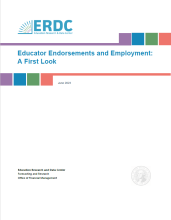Issues regarding educator supply and retention have come to the forefront as the short- and long-term effects of the COVID pandemic have become evident. A national survey conducted in 2021 found that one in four teachers were considering leaving their job by the end of the year—compared to one in six before the pandemic.1 Pandemic or not, retention of educators is vital to student achievement, equitable education and school district fiscal health.2
This descriptive study focuses on Washington educators holding credentials in areas identified as high demand and addresses several questions:
- Does educator retention vary by endorsement (i.e. speciality area)?
- Are educator retention patterns related to educator characteristics and school characteristics?
- To what extent are educators in the public K-12 system employed in other industries, either during their public K-12 employment or after leaving public K-12?
Key findings:
Certain endorsements showed high turnover across all educator and school characteristics. Among educators under age 60:
- Educators with Special Education endorsements had low same-school and low same-district retention rates overall and for most subgroups based on educator and school characteristics. The exceptions were educators under age 40, Black, Indigenous and people of color (BIPOC) educators and educators with less than five years of experience.
- Educators with Bilingual Education endorsements had low same-school and low same-district retention rates overall. Those under age 40 had relatively high public K-12 exit rates. BIPOC educators had high same-district retention rates and low public K-12 exit rates compared with all BIPOC educators.
- Educators with Principal endorsements had low same-school and same-district retention rates overall and in all subgroups because the administrator career track often necessitates such changes. As expected, their exit rates from public K-12 were low for most subgroups. Exceptions to this were educators with Principal endorsements with 15 or more years of experience.
For most educators, public K-12 education employers were the primary source of earnings during calendar years 2016 through 2020. Outside of public K-12 education, top employers were in other education services (including private schools) and public administration (federal, state and local government).
In addition to these findings, this study establishes baseline measures that can be used to evaluate pandemic-related influences once additional data become available.


